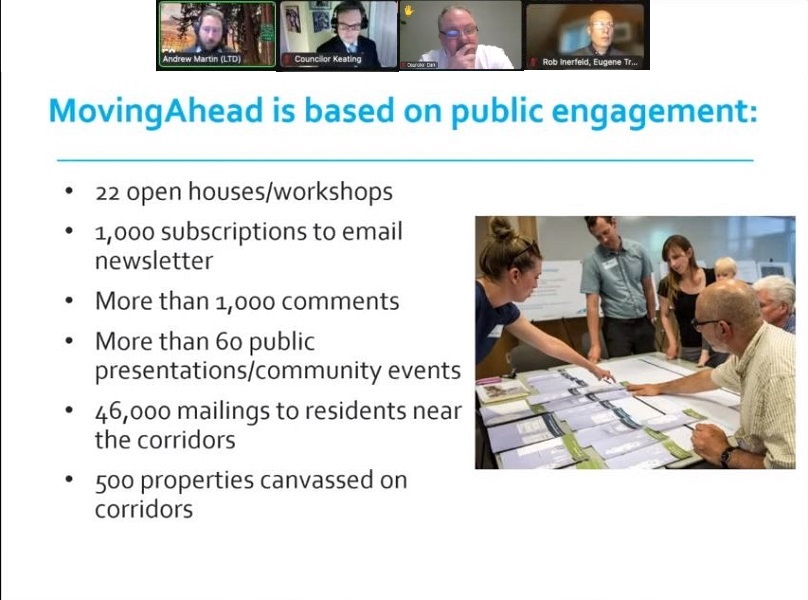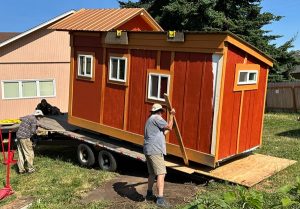MovingAhead update – South Eugene edition
7 min read
Andrew Martin, Matt Keating, Mike Clark, and Rob Inerfeld participated in a joint meeting of the City of Eugene and Lane Transit District on Feb. 28, 2022.
LTD and the City of Eugene continue to exclude South Eugene from transportation and related land-use projects. In a joint meeting Tuesday, the City’s Rob Inerfeld.
[00:00:10] Rob Inerfeld: Next slide please. So for 30th Avenue out to LCC, so this will go on like Oak and Pearl and then Amazon Parkway and then 30th out to LCC.
[00:00:19] And there’s already pretty frequent bus service on that corridor to serve LCC. The studies showed that the enhanced corridor EmX alternatives provided minimal travel times savings and the enhanced corridor wouldn’t even increase ridership. And it, it’s just challenging too, to match up a regular service like an enhanced corridor EmX with the kind of the needs of LCC in terms of, like, time of year, type of things going on throughout the day, when classes start, that sort of thing.
Thank you for supporting
local civic journalism
[00:00:43] More recent studies have shown that transit may be more appropriate— or higher frequency transit—on some other streets parallel to Amazon Parkway like Hilyard and Patterson, which we did not study as part of MovingAhead. So we think it really makes sense for any investment in this corridor to happen after some other studies have been looking at Hilyard and Patterson. The city also has an interest in looking more closely at the part of 30th within the City of Eugene. And also just more recently Lane County is wrapping up their own study of their section of 30th. Next slide.
[00:01:12] John Q: In other words, East 30th was a poor candidate and they should have considered the city’s actual north-south corridors. The Southeast Neighbors Transportation Committee has been commenting before LTD since 2019, asking for clarity about Hilyard-to-East Amazon and South Willamette as corridors. That could affect density under the middle housing code amendments.
[00:01:33] Andrew Martin: Currently LTD operates really frequent buses, whenever LCC is in session, sometimes more frequently than EmX, and that works really well because a lot of the students, they want to get there five minutes before class starts, 10 minutes before class starts, not 30. So we run a lot of buses at one time to get everybody there.
[00:01:51] The major issues we heard about in public feedback around getting to LCC in terms of people, for instance, biking, not taking the bus? They’re really on 30th Avenue in the county-owned portion. And our project didn’t propose any type of investments to make that safer or easier to bike or walk over. The county is looking at that as part of a separate process.
[00:02:12] John Q: Southeast Neighbors also asked Lane County to coordinate with the City of Eugene and LTD, and that the East 30th project area include Amazon Station. Representing Southeast Eugene in Ward 2, Council Member Matt Keating.
[00:02:26] Councilor Matt Keating: The Amazon Station appears to be wholly underutilized right now, and data points from the Southeast Neighbors’ Transportation Committee illustrate that there’s great potential with that Amazon Station.
[00:02:40] Rob Inerfeld: We didn’t really get to that high level of detail around, like, could we create a mobility hub or what kind of facility could we create at Amazon Station?
[00:02:49] You know, one of the challenges with Amazon Station is it’s just not, when you look at creating corridors like these (and Andrew could speak to this in more detail), you look at how many people live within a quarter mile or half a mile of each station that would walk to it. And Amazon Station has a park on one side, so it doesn’t have the kind of trip, the potential ridership from people that would walk to the station. Now, I mean, people can drive there and park there, but there’s a limited number of parking spaces and you’re competing with runners and, and dog people with dogs and that sort of thing. So I don’t know if you want to add—want to elaborate on that, Andrew?
[00:03:20] Andrew Martin: Yeah, I think that was a good answer, Rob. I’ll say we have not had a lot of people use Amazon Station as a Park and Ride and as you mentioned, there’s half of the, half the potential corridor is park and we’re really happy to serve the park, but we frankly don’t see a ton of ridership there. Other studies we’ve done recently have shown if ridership is what we’re looking for—and a lot of the competitiveness if we’re looking for grants is around ridership, though that’s certainly not our only goal—we’re better off running our buses on Willamette Street and on Hilyard and Patterson, probably, just because you’re closer to more people. And that’s, it’s intuitive, but it’s also really true that the closer we are to more people, the more people are going to ride.
[00:03:59] So I will say Amazon Station is great. It’s a great station. It’s very beautiful. And I’m happy that we, we serve it.
[00:04:05] Councilor Matt Keating: Thank you. My final question revolves around preserving neighborhood routes. I hope that our neighborhood routes aren’t sacrificed for any MovingAhead pieces or projects, especially for our most vulnerable residents, seniors, and students who use the neighborhood routes. Andrew, you commented on this last time we had a joint LTD City of Eugene meeting. Can I get assurance that our neighborhood routes won’t be sacrificed by advancing this project?
[00:04:30] Andrew Martin: Nothing in MovingAhead has any, cuts the neighborhood routes except where there are, if we’re replacing a route that currently goes through the neighborhood, we’ve done cost modeling that kind of puts that service back in some modified fashion. So as part of MovingAhead there are no reductions in neighborhood service. So for instance, on River Road, the EmX would terminate at Santa Clara Station if it were built and obviously an EmX bus doesn’t drive around in the neighborhoods up there. That would be placed in our kind of where we’re at with the project with some “unspecified neighborhood service” that we would have to figure out the routing for.
[00:05:07] Councilor Jennifer Yeh: To build off of something Matt asked about the 30th Avenue: So, it sounds like there’s work being done on bike improvements by the county? And I’m wondering if we decided to go with a ‘No Build Alternative’ and there is an opportunity for the sections in the city that might go along with what the county is going to do, is that going to make it so that is a lost opportunity?
[00:05:33] Rob Inerfeld: At the city level, we’re really interested in doing a design study of the section at 30th from Hilyard to Spring Boulevard, which is the county line or where the county jurisdiction happens. We want to look at how can we redesign the street to work better for all modes and not to feel like people that live in the neighborhoods north and south of it feel like it really divides them and that it’s not a safe street. It’s not, doesn’t feel safe to cross. Even if we put a signal in for kids to get to Camas Ridge and, there’s a lot of unease about just speeding traffic there and vehicles not stopping when the light is red.
[00:06:06] And so we really want to look at how to calm the traffic on that section of 30th. And that’s part of the idea of the ‘No Build,’ so we have time to do a study like that and look at how to make that street work better…
[00:06:15] We didn’t even look at redesigning the Eugene section of 30th as part of Moving Ahead. So we were just going to run the buses in mixed traffic on that part. And we weren’t going to really redesign it. So we, but I would say the staff, the city, we see that as one of our priority streets to redesign.
[00:06:31] Councilor Jennifer Yeh: Awesome.
[00:06:32] John Q: To summarize: Staffers toil thanklessly in hopes of federal funding that will benefit the community. LTD has no plans to expand use of the existing Amazon Station and now suggests it was put in the wrong place. While another LTD project planned to eliminate service along most of the north-south corridors in South Eugene, MovingAhead identified those corridors as important and worthy of study. The city and county will work independently on East 30th. And more people are questioning LTD’s public engagement. Councilor Mike Clark.
[00:07:04] Councilor Mike Clark: Could we go back to the slide, the one about public engagement? That’s the one right there. So that looks like thorough and robust public engagement to me, but I have a constituent in my ward who in a very short time, mostly by herself, has managed to get just less than 500 petitions signed, saying that those folks immediately adjacent to that Coburg leg are absolutely against the idea.
[00:07:29] So I’m wondering if staff can help me understand how to square up, this looks like robust public engagement to me, but that’s what she did and I’ve got a pile of signatures, you know, three, four inches high here. Anybody want to try and resolve that for me? Help me understand what’s going on.



